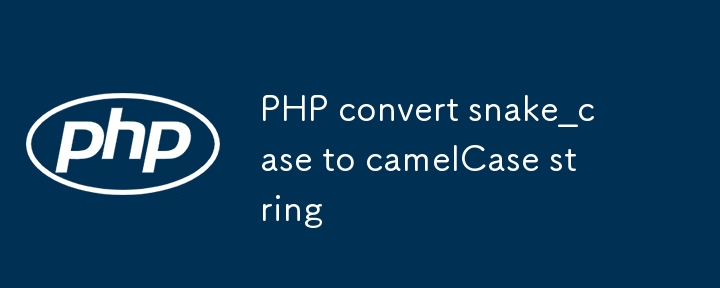Found a total of 10000 related content

PHP string to uppercase
Article Introduction:There are four main ways to convert strings to uppercase in PHP, and the specific choice depends on the usage scenario. 1. Use strtoupper() to convert lowercase letters of the entire string to uppercase, which are suitable for English content, but do not support non-English characters with accents; 2. When dealing with multilinguals, mb_strtoupper() is recommended. It belongs to the mbstring extension and can correctly convert special characters such as French and German. It is recommended to specify the character set to UTF-8 when using it; 3. If you only need to convert the first letter, you can use ucfirst() to convert the first character of the string to uppercase; 4. If you want the first letter of each word to uppercase, you can use ucwords() to be used, which is suitable for formatting titles or usernames to display, but it does not recognize underscores by default.
2025-07-12
comment 0
969

PHP get ASCII value of a character using ord
Article Introduction:The most direct way to get the ASCII value of a character in PHP is to use the ord() function, which returns the ASCII value of the first character of the string. 1.ord() receives a string parameter and only returns the ASCII value of the first character, such as ord('A') returns 65; 2. Be cautious when processing Chinese or special characters, because ord() only returns the first byte value of multi-byte characters, such as ord('In') returns 228; 3. Practical applications include judging character types and implementing simple encryption, such as judging whether it is a letter or number by comparing the ASCII range, or combining chr() to realize Caesar's password displacement.
2025-07-16
comment 0
925

How to convert string case in PHP?
Article Introduction:The methods for converting string case in PHP are: 1. strtoupper() convert all strings to uppercase; 2. strtolower() convert all strings to lowercase; 3. ucfirst() convert the first character of the string to uppercase; 4. ucwords() convert the first letter of each word to uppercase; 5. Use regular expressions and preg_replace_callback() to implement custom conversion; 6. Use mbstring extension to process multilingual text.
2025-05-28
comment 0
923

PHP get the first N characters of a string
Article Introduction:You can use substr() or mb_substr() to get the first N characters in PHP. The specific steps are as follows: 1. Use substr($string,0,N) to intercept the first N characters, which is suitable for ASCII characters and is simple and efficient; 2. When processing multi-byte characters (such as Chinese), mb_substr($string,0,N,'UTF-8'), and ensure that mbstring extension is enabled; 3. If the string contains HTML or whitespace characters, you should first use strip_tags() to remove the tags and trim() to clean the spaces, and then intercept them to ensure the results are clean.
2025-07-11
comment 0
388

PHP convert snake_case to camelCase string
Article Introduction:In PHP, you can use two methods to convert snake_case to camelCase: 1. Use str_replace and ucwords to first uppercase the first letter of the underscore, then remove the underscore, and finally use lcfirst to ensure lowercase; 2. Use preg_replace_callback regular expression to complete the conversion step by step, match the lowercase letters after the underscore and convert them to uppercase; In addition, if the input may be in all uppercase format, it is recommended to convert to lowercase first to ensure consistency. At the same time, pay attention to the underscore when processing strings containing numbers or other symbols, you should ensure that letters are after underscore.
2025-07-11
comment 0
488

Daily JavaScript Challenge #JS- Capitalize the First Letter of Each Word
Article Introduction:Daily JavaScript Challenge: Capitalize the first letter of every word
Hello fellow developers! ? Welcome to today’s JavaScript coding challenge. Let’s keep your programming skills sharp together!
challenge
Difficulty: Easy
Topic: String Operations
describe
Write a function that receives a string as input and returns a string in which the first letter of each word is capitalized. A word is defined as a sequence of characters separated by spaces.
Ready to get started?
https://www.dpcdev.com/
Fork this challenge
Write your solution
Test against the provided test cases
Share your methods in the comments below!
Want to know more letter
2025-01-24
comment 0
790

php get day of week
Article Introduction:The method of getting the day of the week in PHP is as follows: 1. Use the date() function to match the 'w' or 'l' parameters to get the current week in the form of a number or English name respectively; 2. Convert it to Chinese week through a custom mapping array; 3. Use strtotime() to get the week of the specified date; 4. Pay attention to setting the time zone to ensure the accuracy of the results. For example, date('w') returns 0~6 to mean Sunday to Saturday, date('l') returns the complete English week name, and can output Chinese weekdays with a mapping array. When processing non-current dates, you need to use strtotime() to convert it to a timestamp and then pass it in date(). If the result is abnormal, check and set the correct time zone such as Asia/Shanghai.
2025-07-08
comment 0
737

Python convert dict to JSON
Article Introduction:The core method of converting dictionary to JSON in Python is to use the built-in json module. The specific steps are as follows: 1. Use json.dumps() to convert the dictionary to JSON string, supporting common data types; 2. If you include Chinese, you need to add ensure_ascii=False parameter to preserve characters; 3. Complex types such as dates or custom objects need to be converted first or processed with default parameters; 4. When writing to a file, json.dump() should be used and the format can be beautified through indent parameters.
2025-07-12
comment 0
339

php date to timestamp
Article Introduction:There are two main ways to convert date strings to Unix timestamps in PHP. 1. Use the strtotime() function to be suitable for date strings in standard formats, such as "2024-12-2514:30:00", but the processing of non-standard or Chinese format is weak; 2. Use the DateTime::createFromFormat() method to accurately match the specified format, which is suitable for processing non-standard format data, such as user input or CSV data; 3. For date strings containing Chinese characters, they can be converted into standard format first through str_replace() or regular expression before parsing. When selecting a method, you need to judge based on the specific scene: use strto for simple scenes
2025-07-11
comment 0
1022

The Unicode Challenge: Safe String Slicing with `mb_substr()` in PHP
Article Introduction:Using mb_substr() is the correct way to solve the problem of Unicode string interception in PHP, because substr() cuts by bytes and causes multi-byte characters (such as emoji or Chinese) to be truncated into garbled code; while mb_substr() cuts by character, which can correctly process UTF-8 encoded strings, ensure complete characters are output and avoid data corruption. 1. Always use mb_substr() for strings containing non-ASCII characters; 2. explicitly specify the 'UTF-8' encoding parameters or set mb_internal_encoding('UTF-8'); 3. Use mb_strlen() instead of strlen() to get the correct characters
2025-07-27
comment 0
920

php calculate age from date of birth
Article Introduction:The core method of calculating age with PHP is to use the DateTime class and the diff() method. The steps are: 1. Create a DateTime instance of the date of birth and the current date; 2. Call diff() to obtain the time difference and extract the year difference; 3. Pay attention to dealing with non-standard date format and time zone issues. In the specific implementation, it is necessary to ensure that the date format is standardized. You can use strtotime() to convert non-standard formats and clean up Chinese characters through preprocessing. It is recommended to add verification logic; if global users are involved, the DateTime time zone should be manually set to avoid calculation errors caused by server time zone differences, thereby ensuring the accuracy and reliability of age calculations.
2025-07-15
comment 0
275

php get first day of month
Article Introduction:To get the first day of a certain month, it can be implemented through PHP built-in functions. The core methods include: 1. Use the date() function to directly construct the string of the first day of the current month; 2. Use strtotime() to obtain the timestamp; 3. Use the specified date to calculate the first day of the month; 4. Use the DateTime class for object-oriented style processing. In addition, attention should be paid to time zone settings, formatted output and application in database queries. These methods are flexible and suitable for different scenarios, the key is to choose the right approach according to your needs and pay attention to details such as time zone and format control.
2025-07-05
comment 0
541

How to implement a search functionality with LIKE operator wildcards in MySQL?
Article Introduction:To implement the search function of using LIKE operators in MySQL, you need to master the usage of wildcard % and \_, and combine preprocessing statements to ensure security and performance. The specific steps are as follows: 1. Use % to match zero or more characters, such as '%keyword%' to find any text containing keywords; 2. Use \_ to match a single character, such as '\_ohn' to match a four-letter name ending with "ohn"; 3. Use preprocessing statements to bind parameters in back-end languages such as PHP to prevent SQL injection, such as using PDO's prepare and execute methods; 4. In order to implement case-insensitive search, you can use the LOWER() function to convert case uniformly or set appropriate words
2025-08-08
comment 0
749

php get number of days in month
Article Introduction:How to use PHP to get the number of days in a certain month? 1. Use the cal_days_in_month function, which is the most direct way. The syntax is cal_days_in_month(CAL_GREGORIAN, $month, $year); 2. Use the DateTime class and modify method to create the first day of the month and get the date of the last day by adding one month and subtracting one day. Both methods can correctly obtain the number of days. The former is simple and suitable for simple needs, while the latter is suitable for scenarios where DateTime operations are already available or requires more time to process.
2025-07-06
comment 0
881

Advanced String Manipulation and Character Encoding in PHP
Article Introduction:The default string function of PHP is byte-based, and it will cause errors when dealing with multi-byte characters; 2. Multi-byte security operations should be performed using mbstring extended mb_strlen, mb_substr and other functions; 3. mb_detect_encoding and mb_convert_encoding can be used to detect and convert encoding, but metadata should be relied on first; 4. Normalizer::normalize is used to standardize Unicode strings to ensure consistency; 5. In actual applications, safe truncation, case comparison and initial letter extraction should be achieved through mbstring functions; 6. mbstring and
2025-07-28
comment 0
598

php get start of year
Article Introduction:Getting the start of a year in PHP can be achieved through the strtotime function or the DateTime class. The way to use strtotime is: $firstDayOfYear=strtotime('2024-01-01'); or dynamically get the current year: $year=date('Y'); $firstDayOfYear=strtotime("$year-01-01"); You can also use DateTime object-oriented method: $date=newDateTime('2024-01-01'); or $date=newDateTime('first
2025-07-04
comment 0
830

php get yesterday's date
Article Introduction:There are three ways to get yesterday's date in PHP: use the strtotime() function, combine the date() function to output detailed time, or use the DateTime class for flexible processing. The first method directly obtains yesterday's date through echodate('Y-m-d',strtotime('yesterday')); the second method can output the full time containing time, minutes and seconds, such as echodate('Y-m-dH:i:s',strtotime('yesterday')); the third method uses the object-oriented DateTime class to facilitate the execution of complex date operations, such as adding and subtracting days or setting time zones, with the code as $date=n
2025-07-04
comment 0
171

How to add a search filter to a table in Bootstrap
Article Introduction:To add search filtering function to Bootstrap table, you need to first create a table with a search input box and implement filtering logic with JavaScript: 1. Use Bootstrap form class to create a search input box and place it above the table; 2. Bind keyup events for the input box through JavaScript, get the search terms entered by the user and convert it to lowercase; 3. Iterate through all cells in each row of the table and check whether the content contains search terms (case insensitive); 4. If any cell of a row matches, the row will be displayed, otherwise it will be hidden; 5. Optional optimizations include searching only for specific columns, anti-shake processing, displaying "no result" prompts, etc.; this method is purely implemented with no jQuery or plug-in, suitable for use in
2025-08-20
comment 0
757

Mastering Complex Sorting in PHP with `usort` on Multidimensional Arrays
Article Introduction:usort() is the preferred method for handling complex sorting of PHP multidimensional arrays. It supports multiple sorting conditions, mixed data types, and dynamic priorities through custom comparison functions. 1. When using usort(), the array and callback function are passed, the callback receives two subarray elements and returns the comparison result, and uses functions such as operators or strcasecmp() to implement sorting logic; 2. For multi-condition sorting, the fields and directions can be dynamically specified through the createSortCallback() function, first in descending order of score and then ascending order in age; 3. String sorting should be done using strcasecmp() to achieve case insensitiveness, or the Collator class supports internationalized characters; 4. Pay attention to usort(
2025-08-08
comment 0
220

php convert date format
Article Introduction:PHP date format conversion is mainly implemented in two ways. First, use the combination of date() and strtotime() functions, which are suitable for most standard format conversions, but have limited support for non-standard formats; second, use the DateTime class to deal with more complex scenarios, such as time zone conversion and multilingual support, which has stronger readability and fault tolerance; in addition, you also need to master common format characters, such as Y represents a four-bit year, m represents a month with a leading zero, and d represents a date with a leading zero, etc.; it is recommended to use date() in simple scenarios, and DateTime is preferred if it involves time zone or internationalization, and pay attention to verifying the legitimacy of the input.
2025-07-07
comment 0
909



















